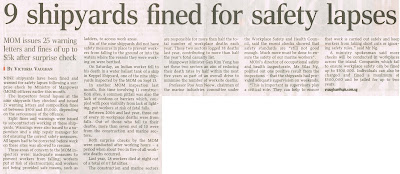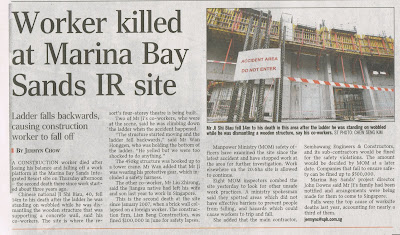A construction worker died after falling off a building under construction while erecting a formwork. |
On the incident night, at around However, one of the lifting attachments caught the rebar cage beside the formwork. The rebar cage was pulled out of its position by the crane and toppled 20m to the ground below. The worker who had earlier anchored his safety harness to the rebar cage fell together with it. |
For crane operators: 1. Prevent Entanglement of Load Line: Crane operators need to be alert throughout the entire lifting process. Before moving the crane’s load line, the crane operator must ensure that there is no entanglement of load line or slings with objects nearby. If the operator does not have a clear view of the lifting operations, he should adhere closely to the instructions of the signalman. In this incident, the slings (with the attachments) should have been raised sufficiently above the height of the rebar cage before slewing them over the cage. 2. Stop Slewing if movement is not smooth: The crane operator should avoid sudden movements of the load line at high speed. Start any lifting process slowly so that any abnormalities can be detected. If the operator feels abnormal resistance to the crane’s movement, he should halt the process and check (with the aid of the signalman) for possible entanglement. For lifting crew: 3. Lifting Signalman: Lifting signalman must stay alert throughout the lifting operation, particularly during slewing of the load line. He must halt the lifting process immediately in the event of a load line entanglement. 4. Effective Communication: A system must be in place to ensure effective communication between lifting personnel, particularly between the operator and signalman. This could be done through: General recommendations: 5. Conduct Risk Assessment: Prior to the start of work, conduct an adequate risk assessment to identify all potential hazards and the risks involved. Appropriate control measures and safe work procedures must be established and implemented. For this case, some of the potential hazards include: • Possible entanglement of load line with surrounding structures 6. Safe Lifting Procedure: Companies should put in place procedures to mitigate the risk of load line getting entangled with the surrounding structures. These could include ensuring that: • Lifting signalman have clear sight of the lifting process at all time 7. Safe working at height: Companies involved in works carried out at height must implement appropriate fall protection measures for workers. When fall arrest systems are utilised, proper anchorage points or anchorage systems must be made available. In addition, if works are to be carried out at night, sufficient lighting must be provided.
1) Factories (Operation of Cranes) Regulations 2) |






